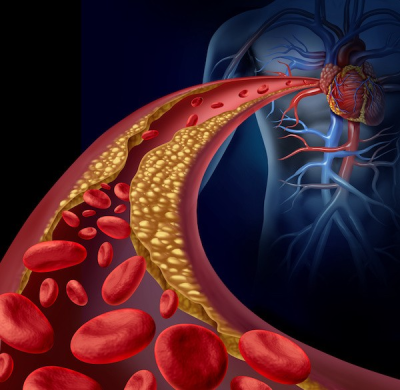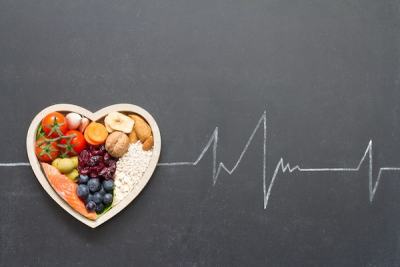How to manage high cholesterol?
Author: Ondrej Stovicek
High cholesterol is one of the key health risks linked to cardiovascular diseases, including heart disease and stroke. Monitoring and managing cholesterol levels in the body is crucial, as an excessive amount of "bad" LDL (low-density lipoprotein) cholesterol can increase the risk of these potentially fatal conditions. Many people turn to various strategies to combat high cholesterol, including dietary changes, exercise, and medication. An emerging trend in alternative treatments for lowering cholesterol is the growing interest in cannabis and its derivatives, including cannabidiol (CBD).
CBD, a compound found in cannabis, has been studied for its potential therapeutic effects on various ailments, including its possible role in managing cholesterol levels.
In this article, we will explore the basics of cholesterol, its connection to cardiovascular diseases, and treatment options for high cholesterol (lowering cholesterol levels in the body), including those involving cannabis and CBD.
What is cholesterol?
Cholesterol is a fatty substance essential for the proper functioning of the human body. It is a lipid found in cell membranes and plays a vital role in the production of hormones, vitamins, and bile acids. Cholesterol is produced by the body, primarily in the liver, but it can also be obtained from food.
There are two main types of cholesterol in the blood:
-
LDL (low-density lipoprotein) cholesterol: This type is often referred to as "bad" cholesterol because excessive levels of LDL cholesterol in the blood can lead to cholesterol buildup on the walls of arteries, forming atherosclerotic plaques. These plaques can narrow the arteries, restricting blood flow and increasing the risk of heart disease.
-
HDL (high-density lipoprotein) cholesterol: This type is known as "good" cholesterol because it can remove excess cholesterol from the blood and transport it back to the liver, where it is metabolized and eliminated from the body. Higher levels of HDL cholesterol are associated with a lower risk of heart disease.
Maintaining a proper balance between LDL and HDL cholesterol is important for heart and vascular health. High LDL cholesterol and low HDL cholesterol can increase the risk of atherosclerosis and heart disease. Therefore, monitoring cholesterol levels and taking steps to maintain this balance is key to preventing heart issues.
What is the link between cholesterol and heart health?
The relationship between cholesterol and heart health is closely tied to the occurrence of cardiovascular diseases, particularly atherosclerosis and heart disease. Atherosclerosis is a process in which cholesterol and other substances build up on the inner walls of arteries (the vessels that carry blood to the heart and other parts of the body). This process can gradually narrow the arteries, leading to the formation of atherosclerotic plaques. The impact of cholesterol on heart health can be summarized as follows:
- Excess LDL cholesterol: High levels of "bad" LDL cholesterol in the blood can cause more cholesterol to deposit on the walls of arteries. These plaques can harden and become brittle, making blood flow more difficult and increasing the risk of atherosclerosis.
- Atherosclerotic plaques: These plaques, containing cholesterol, lipids, calcium, and other substances, can grow and narrow the blood vessels. If a plaque ruptures or breaks apart, it can lead to the formation of a blood clot, which may block the artery entirely. This can result in a heart attack (myocardial infarction) or stroke, both of which are serious cardiovascular diseases.
- Role of HDL cholesterol: Conversely, "good" HDL cholesterol has the ability to remove excess cholesterol from artery walls and transport it back to the liver for metabolism and elimination. Higher levels of HDL cholesterol are associated with a reduced risk of atherosclerosis and heart disease.
Overall, high LDL cholesterol and low HDL cholesterol can increase the risk of developing atherosclerosis and heart disease. Therefore, it is important to monitor cholesterol levels and take steps to maintain a healthy balance between good and bad cholesterol. This may include dietary changes, exercise, and in some cases, medication under a doctor’s supervision.
How is cholesterol measured?
Cholesterol is measured through a blood test known as a "lipid profile" or "cholesterol test." This test is performed to determine the levels of various lipids, including total cholesterol, LDL (low-density lipoprotein) cholesterol, HDL (high-density lipoprotein) cholesterol, and triglycerides in the blood.
The process typically involves:
- Preparation: Generally, no special preparation is required before the test. However, your doctor or lab technician may ask you to fast (not eat or drink) for a certain period before the test, usually 9 to 12 hours.
- Blood sample collection: A healthcare professional will draw a blood sample, usually from the arm. A small amount of blood is collected, which is sufficient for the test.
- Sample analysis: The blood sample is sent to a lab where the levels of different lipids are measured, including total cholesterol, LDL cholesterol, HDL cholesterol, and triglycerides.
- Results: After analysis, you will receive your lipid profile results from your doctor or healthcare provider, who will interpret the findings in the context of your overall health and risk factors for heart disease.
How can high cholesterol be lowered?
Cholesterol levels can be reduced through lifestyle changes and conventional treatment methods.
Dietary Changes:
- Reduce intake of saturated fats: Limit the consumption of foods high in saturated fats, such as fatty meats, fried foods, and full-fat dairy products. Replace them with foods lower in saturated fats, such as poultry, fish, nuts, and seeds.
- Increase fiber intake: Consume foods rich in soluble fiber, such as oats, whole-grain bread, and legumes. Fiber can help reduce LDL cholesterol levels.
- Limit trans fats: Trans fats are artificial fats often found in processed foods like chips and fried items. Reducing their intake can help lower LDL cholesterol levels.
- Eat "healthy" fats: Include healthy fats, such as unsaturated fats found in olive oil, avocados, nuts, and fish like salmon or tuna.
- Physical activity: Regular exercise can help increase HDL cholesterol and lower LDL cholesterol. Aim for at least 150 minutes of moderate-intensity exercise per week.
- Medications: In some cases, medication may be necessary to lower cholesterol, especially if lifestyle changes alone are insufficient. Drugs such as statins, fibrates, or cholesterol absorption inhibitors may be prescribed by a doctor.
How can CBD help with high cholesterol?
Cannabis interacts with the body's endocannabinoid system (ECS), which includes CB1 and CB2 receptors.
The CB1 receptor is involved in the reverse cholesterol transport (RCT) process, where the body regulates cholesterol levels by removing excess cholesterol and transporting it to the liver.
Chronic inflammation is a contributing factor to high cholesterol and cardiovascular diseases. CBD has been shown to have anti-inflammatory properties through its interaction with ECS receptors, which may help reduce inflammation in the body.
CBD may indirectly influence cholesterol levels by potentially aiding in weight regulation. Obesity and overweight are risk factors for high cholesterol. CBD may help with weight loss by promoting the conversion of white fat to brown fat, which is more easily burned as energy. By supporting weight regulation, CBD may contribute to lowering cholesterol levels.
CBD has also shown potential in reducing anxiety and stress, which are often associated with unhealthy lifestyle habits. By alleviating anxiety and stress, CBD may indirectly contribute to cholesterol regulation by encouraging healthier habits and reducing the likelihood of behaviors that could negatively impact cholesterol levels.
While CBD shows promise in potentially aiding cholesterol management, it should not be considered a standalone treatment. A comprehensive approach to cholesterol management is needed, including a healthy diet, regular exercise, and medical advice. Before incorporating CBD or any other supplement into a cholesterol management routine, it is recommended to consult with a healthcare professional.
In 2020, a clinical study examined the effects of CBD oil on 65 overweight individuals. Researchers found that participants who took 15 milligrams of CBD daily experienced an improvement in HDL cholesterol levels, whereas the control group saw no such improvement. Those who took CBD also reported better sleep and improved stress resilience.
How to use CBD for high cholesterol
When it comes to dosage, caution is key. Start slowly and increase gradually.
It's important to remember that CBD does not work the same way for everyone, and the ideal dosage can vary. The recommended dosage for cholesterol reduction differs for a child versus an adult man.
Based on the most recent study from 2020, as mentioned earlier, we suggest starting with a daily intake of 15 mg of CBD (equal to 4 drops of 10% CBD oil, ideally divided into two doses per day) for adults.
Dosage can be increased if the desired effect is not achieved.
Foods beneficial for cholesterol control
Foods beneficial for cholesterol control typically help reduce "bad" LDL cholesterol levels and increase "good" HDL cholesterol levels. Here are some recommended foods:
- Oatmeal: Oats contain soluble fiber known as beta-glucan, which helps lower LDL cholesterol. Starting your day with oatmeal can be beneficial.
- Whole grains: Foods like whole-grain bread, brown rice, and whole-wheat pasta are rich in fiber, which can help lower LDL cholesterol.
- Nuts: Nuts such as almonds, hazelnuts, and walnuts are high in unsaturated fats that can help lower LDL cholesterol. However, keep in mind that nuts are calorie-dense, so they should be consumed in moderation.
- Fish: Fish like tuna, salmon, mackerel, and herring are rich in omega-3 fatty acids, which have positive effects on heart health and can reduce triglycerides and LDL cholesterol.
- Olive oil: Olive oil contains healthy unsaturated fats and antioxidants that may help reduce LDL cholesterol. Use it for cooking and salad dressings.
- Hemp oil and seeds: These can help maintain optimal cholesterol levels in the blood.
- Legumes: Peas, beans, lentils, and other legumes are rich in soluble fiber and protein, which can help lower LDL cholesterol.
- Fruits and vegetables: Fruits and vegetables are low in fat and high in fiber, vitamins, and antioxidants. Consuming a variety of colorful fruits and vegetables can support overall heart health.
- Tea: Certain types of tea, especially green tea, contain catechins that may help lower LDL cholesterol.
- Avocado: Avocados are rich in healthy unsaturated fats and fiber, which can help reduce LDL cholesterol levels.
- Celery and apple juice: These are natural options for lowering cholesterol levels.
Are cholesterol medications necessary?
The need for cholesterol-lowering medications depends on several factors, including cholesterol levels, risk factors for heart disease, and the individual’s overall health. For some people, medications may be essential, while for others, dietary and lifestyle changes may be sufficient.
Risk factors for high cholesterol
Risk factors for high cholesterol can include genetic, lifestyle, and health-related factors that can increase LDL cholesterol levels and the overall risk of heart disease and atherosclerosis.
Key risk factors include:
- Heredity: Genetics play a significant role in cholesterol levels. If there is a family history of high cholesterol or heart disease, the risk may be higher.
- Dietary habits: Consuming foods high in saturated fats and trans fats (artificial fats) can raise LDL cholesterol. A diet high in refined sugars and unhealthy fats can also negatively impact cholesterol levels.
- Lack of physical activity: A sedentary lifestyle can lead to weight gain and increase the risk of high cholesterol.
- Overweight and obesity: Excess body weight can raise LDL cholesterol and lower HDL cholesterol levels.
- Smoking: Smoking can decrease HDL cholesterol and increase the risk of heart disease.
- Diabetes: People with diabetes often have disrupted fat metabolism and may have higher levels of LDL cholesterol and triglycerides and lower levels of HDL cholesterol.
- Stress: Chronic stress can have a negative impact on cholesterol levels.
- Age and gender: Cholesterol levels tend to increase with age, especially in men. After menopause, women also tend to have higher LDL cholesterol levels.
- Alcohol: Excessive alcohol consumption can raise triglyceride levels and negatively affect cholesterol levels.
- Other health conditions: Certain health conditions, such as hypothyroidism (underactive thyroid) or kidney disease, can impact cholesterol levels.
How often should cholesterol be checked?
The frequency of cholesterol checks should be determined by a healthcare provider based on your health status, age, risk factors, and family history of heart disease. However, there are general guidelines for cholesterol monitoring:
- Routine check-ups: Most doctors recommend checking cholesterol levels during regular preventive health exams. The frequency will depend on your age, gender, health status, and risk factors.
- Children and adolescents: Cholesterol levels in children and adolescents should be checked if there is a family history of high cholesterol or heart disease. The first check can be done between ages 9 and 11.
- Adults: For adults without significant risk factors, cholesterol levels are typically checked every 4-6 years. However, if you have any risk factors (e.g., smoking, high blood pressure, diabetes, obesity, or a family history of heart disease), more frequent checks may be necessary, usually annually or as advised by your doctor.
- Seniors: Older adults, especially those with risk factors or diagnosed cardiovascular disease, may require regular cholesterol monitoring.





